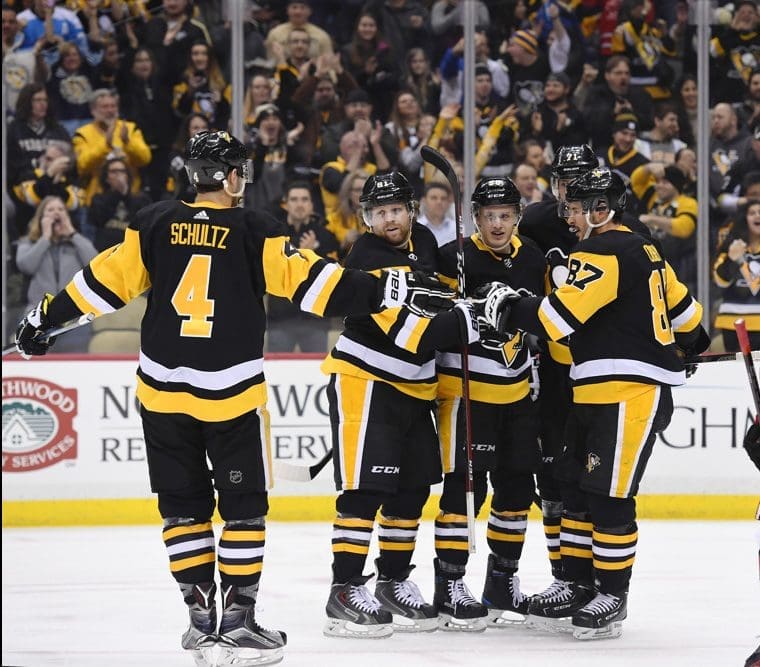Matt-Alytics
Matt-alytics: Power Plays Could Be Two-Sided Blade
You probably know the numbers by now, but they deserve a quick rehash.

CRANBERRY TOWNSHIP, Pa. — You probably know the numbers by now, but they deserve a quick rehash.
The Penguins set a franchise record in 2017-18 with a 26.2 percent power-play conversion rate, edging out a particularly potent 1995-96 squad that featured the show-stopping talents of Mario Lemieux, Jaromír Jágr, Ron Francis and Sergei Zubov. Not that Sidney Crosby, Evgeni Malkin and Phil Kessel needed further validation of their abilities, but that’s another feather in their respective caps.
To put that level of success in greater league-wide context, the Penguins’ power play was the most efficient over a full season in nearly three decades. (The 2012-13 Capitals clicked at 26.8 percent, but played just 48 games due to the work stoppage.)
You have to go back to 1989-90 to find a better 82-game conversion rate, the 27.7 percent mark posted by the Flames. With the preponderance of video scouting in today’s game — an aspect that typically helps defense more than offense — what the Penguins did with the extra man this season was stunning.
The Saving Grace
This year’s Penguins team scored a man-up goal in 47 of their 82 games, including multiple-goal outings in 17 of those. Given the Penguins’ minus-16 goal differential at five-on-five, it’s probably not a stretch to say the power play saved the season for them, especially early when they were abysmal at even strength.
“The guys that are on (the power play) have done a consistent job all year long,” Mike Sullivan said Monday at UPMC Lemieux Sports Complex. “It’s been one of the more consistent aspects of our overall team game. We expect them to continue to be that difference-maker if and when those opportunities present themselves. I think our power play certainly has an influence on our overall team game.”
All told, the power play connected 68 times on 260 opportunities. That figures out to 3.17 opportunities per game, the eighth-most in the NHL. Try as they might, opponents couldn’t help but put Pittsburgh on the advantage this season.
“I can’t speak for our opponents (but) I know if I was coaching against our team I would not want to give our power play that many opportunities,” Sullivan said. “But I do believe our power play gives our team a certain level of confidence.”
The deeper numbers on the power play are also encouraging.
First of all, the conventional wisdom holds that teams get fewer power-play chances in the postseason, but that supposed officiating adjustment hasn’t really manifest in the past two playoff years for the Penguins. Last season, they received 3.17 chances per game in the regular season and 3.12 in the playoffs. To this amateur statistician, that’s well within the parameters of randomness, as is the small drop from 3.18 in the 2015-16 regular season to 3.08 that spring.
Secondly, the Penguins had the fifth-best Expected Goals (xG) rate in the NHL on the power play, creating 8.28 goals per 60 minutes of five-on-four time. They slipped a touch late in the season, but this isn’t a power play that’s propped up by an unrealistic shooting percentage.
Fly in the Ointment?
On the other hand, the Penguins’ penalty kill is a real concern. While they had some success for a stretch in the middle of the season, they conceded too many goals and chances in the homestretch.
Overall, the numbers don’t look half-bad, with the Penguins finishing 13th in the league in kill rate, at 79.7 percent. From Thanksgiving through the Feb. 26 trade deadline, they held opposing power plays off the board in 27 of 40 games. (Before you go there, Ian Cole was scratched in 17 of those 40 games.)
But if we hone in on the final 25 games, a time frame that has proven to be rather predictive when it comes to playoff results, the Penguins rank 27th in the league with a 71.4 percent kill rate and 21st with a 7.62 xG against per 60 minutes. In other words, goaltending isn’t the only thing that’s let the penalty kill down.
Considering that the Penguins have controlled the even-strength shot and Expected Goals share better than the Flyers this season, should they be hoping for a five-on-five series? I wouldn’t go quite that far, but I could see the argument, since the Flyers’ power play could find a groove with its collection of high-end talent .
“They have a lot of good players out there,” Carl Hagelin said. “I think that’s the bottom line. They’ve played together for a while and they know where they’re gonna be.”
Sounds a lot like the Penguins’ power play, which will be taking on a Flyers PK that ranked 29th during the regular season despite a fourth-place ranking in xG against. Taking that data on the whole, Philly is probably not that bad at killing penalties, but I’d like the Pittsburgh power play in that matchup, and not by a small margin.
If the whistles don’t work in this series, it shouldn’t kill the Penguins’ chances at all, but a few more penalties would likely give them an extra boost as the quest for a three-peat begins.












